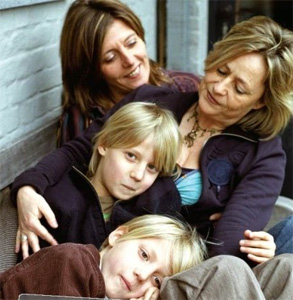It is now 10 years since the start of legal recognition for same sex unions in Vermont, just 11 years after a comparable start in Denmark. For a time, both Vermont in the US and Denmark internationally were seen as remarkable exceptions: idiosyncracies in that were unlikely to be emulated in more mainstream states and nations. However, after some initial delay, and increasing number of others followed, and even upped the game.
MONTPELIER, Vt.—When Lois Farnham and Holly Puterbaugh were joined in civil union 10 years ago Thursday, some of their friends didn't come for fear they'd lose their jobs, and the church asked that plainclothes police officers attend the ceremony in case there was trouble.
A decade later, Vermont and four other states—Massachusetts, Connecticut, New Hampshire and Iowa, as well as the District of Columbia—have instituted full marriage for same-sex couples, and the Burlington couple say many people view their relationship as "ho-hum."
Vermont was the first jurisdiction in the country to offer most of the legal rights and responsibilities of marriage to same-sex couples. Massachusetts instituted full same-sex marriage in 2004 in response to a state court's order. Last year, Vermont's Legislature became the first to approve full marriage for those couples without a court's prompting.
"At the time, civil unions were so radical," Farnham said this week. "Now it's the fallback, conservative issue."
What has been remarkable in recent years though, is how quickly, after the slow beginning, the idea has spread. In Europe, almost all countries have or are planning some form of provision for same sex partnerships, and seven have already upgraded to full marriage, with more on the way. In the US, early progress towards marriage equality was meet with a strong political backlash, but even here progress has been substantial and is accelerating.
Even with the heartbreaking ballot losses in California and Maine, five states now have full state level provision for marriage equality, and many more states and even cities have local provision for varying grades of partnership recognition, from simple registration of domestic partnerships, to strong unions which are "marriage in everything but name". On the other hand, the political push against equality appears to have run out of steam: in Iowa, the NOM made highly visible donations to promote the primary elections campaigns of marriage foes - and lost badly. In this year's mid-terms, there are no new states with anti-marriage ballot initiatives, while it's a fair bet that in 2010 California will be the first state to have a ballot question to remove restrictions on marriage - which is likely to be successful. Other states will follow.It is also arguable that the fight for marriage equality, while i has been slow, has been a catalyst for many other, lower profile moves which have been finding it easier to gain public acceptance, and which are now bearing fruit in national, state and local government, and in private businesses.
All big movements build gradually, with small incremental gains increasing over time. However, there are also major landmarks along the way to add impetus and momentum. Stonewall was one of the major landmarks on the route to LGBT equality. Vermont's civil union legislation was another. Let us all join in congratulations, and thanks, to the small state of Vermont for the giant contribution of their vision and foresight.







